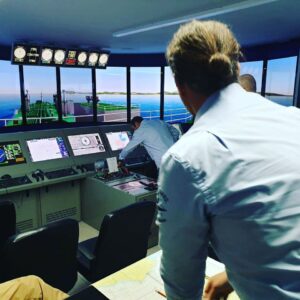
BRM/BTM BRIDGE SIMULATOR REFRESH
COURSE CATEGORY: Operational Deck
DURATION: 3 Days
Course recommended by:

![]()
COURSE OBJECTIVES AND BENEFITS
BRM/BTM/Ship Handling/Bridge Simulator Refresh course is a refresh syllabus on BRM/BTM, using a 360 full mission bridge-room simulator.
Our instructor sets and controls exercises. Initially, he allows the trainees to become familiar with the equipment, controls and instrumentation provided by the simulator.
Set exercises increase in complexity as the course progresses. Complexity increases as trainees become familiar with the ship model’s maneuvering characteristics and its response to engine and helm in various conditions. Final exercises deal with the planning and execution of a coastal passage from port to port. They will make use of the knowledge and skills learned in all of the previous exercises. The instructor will introduce equipment failure or malfunction during the latest exercises to afford trainees practice in taking emergency preventive action and to practice on bridge teamwork in critical situations.
During exercises, trainees need to use effective bridge procedures, following International Regulations for Preventing Collisions at Sea (COLREG 1972). They also need to observe the basic principles of keeping a navigational watch, as set out in regulation VIII/2, section A-VIII/2 and B-VIII/2 of the STCW Convention and Code as amended. Trainees will assume the different roles of the bridge watchkeeping team. These roles will be rotated to allow each trainee an opportunity to act as master for some of the exercises.
A session for briefing and planning will precede each exercise and a debriefing will follow.
Objective
The trainees who successfully complete this course will have gained experience in handling ships under various conditions. They could also make a more effective contribution to the bridge team during ship maneuvering in normal and emergency situations.
In particular, trainees will gain:
a) familiarization with the use of engines and helm for ship maneuvering
b) understanding of the effects on the behaviour of the ship of wind, current, shallow water, banks and narrow channels and condition of loading
c) greater awareness of the importance of planning a passage or maneuver and the need for an alternative plan
d) greater understanding and awareness of efficient bridge procedures and bridge teamwork during watchkeeping and ship handling; in normal and in emergency situations
e) greater awareness and understanding of a good interactive communication style and benefit of building up a common shared mental model of the planned passage.
This course is recommended by OCIMF’s SIRE 2.0/Rightship’s RISQ 3.1 protocols.


